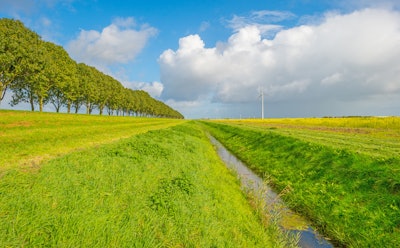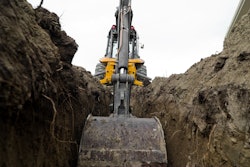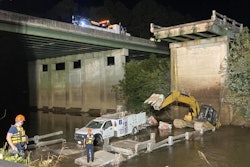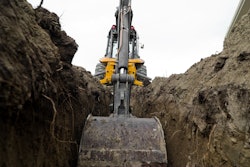
Roadbuilding and contractor groups find themselves once again fighting definitions of “waters of the U.S.”
How waters are defined by the federal government – and more important, how those waters are regulated – has been the subject of a more than 15-year legal battle. At stake, say the groups, is the ability to efficiently implement the $1 trillion infrastructure law, as well as other construction projects.
“For too long, our members have had to spend countless hours and dollars navigating an unclear and often punitive permitting system where even dry land may arbitrarily be considered a federally regulated water,” says Michael W. Johnson, president and CEO of the National Sand, Stone & Gravel Association.
The American Road and Transportation Builders Association has said waters have been so broadly defined that roadside ditches could be regulated, delaying transportation projects and increasing costs.
The Clean Water Act calls for regulating pollution that enters “navigable waters,” a term that is not defined.
Both NSSGA and ARTBA have filed a brief with the U.S. Supreme Court in support of waters definitions that are more narrow and would leave out ditches and wetlands that do not abut navigable waters. Their brief contends the regulations are “impacting the ability to efficiently supply the materials needed for and to build the infrastructure projects under the Infrastructure Investment and Jobs Act, as well as increasing the costs of public works across the country without environmental improvement.”
Changing definitions
In 2020, the Trump administration’s Navigable Waters Protection Rules replaced the Obama-era Waters of the U.S. rules by more narrowly defining navigable waters.
The new rules excluded, among other things, many ditches and areas that only contain water in direct response to rainfall. It left regulations of those to the states.
For federal authority, it focused on the following waters: oceans and navigable rivers, perennial and intermittent tributaries, certain lakes and ponds, and wetlands adjacent to jurisdictional waters.
It didn’t take long for those rules to be challenged in court. On August 30, a U.S. District Court in Arizona threw out the Trump rules.
Since then, federal agencies have reverted to the more broadly defined Waters of the U.S. rules. The U.S. Environmental Protection Agency and the Department of the Army are developing revisions to the rules and have committed to the more broader definition of waters.
Meanwhile, the U.S. Supreme Court is scheduled to hear arguments on the case in October, with a ruling expected in 2023.
“The transportation construction industry needs regulatory clarity to deliver economic benefits from record new federal highway investment,” ARTBA President & CEO David Bauer said. “The Court has the opportunity to end decades of unpredictable agency decisions, deliver clarity and help us demonstrate that infrastructure improvements and environmental stewardship need not be conflicting objectives.”
The case
The case before the Supreme Court was filed by Idaho property owners Michael and Chantell Sackett against the EPA. The Sacketts bought two-thirds of an acre in a neighborhood in 2004. They got local permits for construction of a home, which they began building in 2007. But the EPA later ordered them to stop construction and to restore the property to pre-construction conditions because it claimed navigable waters were on it. The Sacketts sued.
According to the Sacketts’ brief, their property does not contain a stream, river, lake or similar waterbody. The Sacketts’ property has wetlands on it that are separated from other wetlands by a 30-foot-wide road. The wetlands across the road are connected by a manmade ditch that leads to a creek that leads to a lake. The Sacketts contend none of these connecting bodies are navigable waters.
The Supreme Court has sent mixed signals in the past as to what constitutes a navigable water. A majority ruled in 2006 that wetlands must abut other regulated waters to be under federal authority. However, Justice Anthony Kennedy, who has since retired, also wrote that a wetland would be regulated if it significantly affects the integrity of a traditional navigable water.
The Associated General Contractors of America has also filed a friend-of-the-court brief siding with the Sacketts. It asks the court to maintain the majority opinion on a wetlands definition, minus Kennedy’s added test.
AGC notes that construction projects in or near waters require costly and time-consuming federal permits before breaking ground, and site owners may be subject to criminal and civil penalties.
“AGC members depend on the stability and predictability of the federal government’s permitting process, which is a prerequisite to hundreds of billions of dollars in investments each year and massive amounts of economic activity,” AGC’s brief states.
Federal waters definition
The EPA and Army agree the waters of the U.S. need to be clearly defined and have been working on new proposed rules. The rules are based on the ones the Sacketts are challenging.
“This proposed rule would support a stable implementation of ‘waters of the United States’ while the agencies continue to consult with states, Tribes, local governments, and a broad array of stakeholders in both the implementation of WOTUS and future regulatory actions,” says an EPA press release in November.
Meanwhile, the EPA is defining regulated, navigable “waters of the U.S.” as:
1. All waters which are currently used, or were used in the past, or may be susceptible to use in interstate or foreign commerce, including all waters which are subject to the ebb and flow of the tide;
2. All interstate waters including interstate wetlands;
3. All other waters such as intrastate lakes, rivers, streams (including intermittent streams), mudflats, sandflats, wetlands, sloughs, prairie potholes, wet meadows, playa lakes, or natural ponds, the use, degradation or destruction of which could affect interstate or foreign commerce including any such waters:
- a. Which are or could be used by interstate or foreign travelers for recreational or other purposes; or
- b. From which fish or shellfish are or could be taken and sold in interstate or foreign commerce; or
- c. Which are used or could be used for industrial purposes by industries in interstate commerce;
4. All impoundments of waters otherwise defined as waters of the United States under this definition;
5. Tributaries of waters identified in paragraphs (1) through (4) of this section;
6. The territorial sea;
7. Wetlands adjacent to waters (other than waters that are themselves wetlands) identified in paragraphs (1) through (6) of this section; waste treatment systems, including treatment ponds or lagoons designed to meet the requirements of CWA (other than cooling ponds as defined in 40 CFR 423.11(m) which also meet the criteria of this definition) are not waters of the United States.
Waters of the United States do not include prior converted cropland. Notwithstanding the determination of an area’s status as prior converted cropland by any other federal agency, for the purposes of the Clean Water Act, the final authority regarding Clean Water Act jurisdiction remains with EPA.















